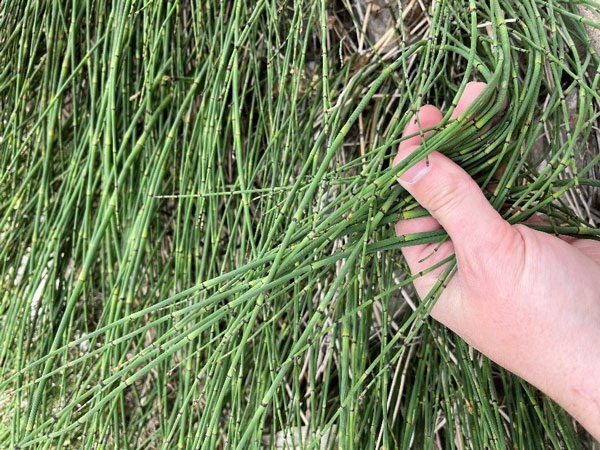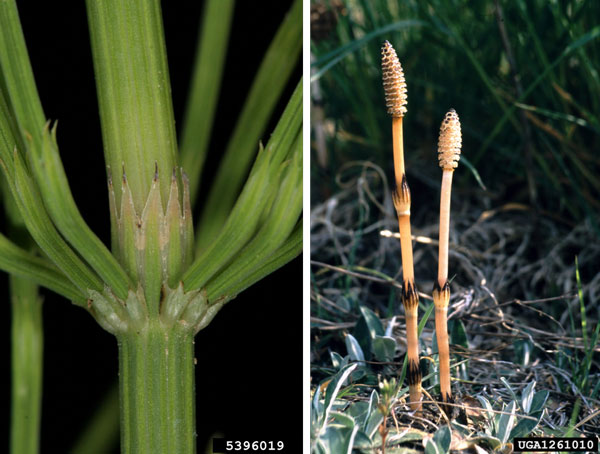Extension Weed Science Specialist, Sarah Lancaster, recently received a photo of an unknown weed that is nearly impossible to control with herbicides (Figure 1). The weed is an Equisetum species, also known as horsetails. Two Equisetum species in Kansas are field horsetail (E. arvense) and scouring rush (E. hyemale). These are prehistoric plants that can be found in the fossil record before dinosaurs. So, it’s not surprising that they are pretty resilient!

Figure 1. Photo of an Equisetum species (likely scouring rush) submitted for identification.
Ecology
Horsetails are generally found in moist soils, such as those found in forests, ditches, or the margins of water bodies. It can grow in either sunny or shaded sites. They contain high concentrations of silica, which made them useful to Native Americans for polishing or scouring. Scouring rush was also used as a drinking straw. Because of the chemical composition, stems typically stand for more than one year. Horsetails have a neurotoxin that can harm livestock, but animals will rarely graze them unless harvested as hay or during winter.
Identification
Horsetails have upright, round, evergreen stems that emerge from rhizomes to form dense stands. Tubers are also found in the field horsetail's root system and sometimes on scouring rush. Stems can be from 7 inches to over 6.5 feet tall with vertical ridges (silica deposits). Dark, toothed bands form at the nodes. The stems of both horsetail species are hollow, with a larger cavity (about ¾ of the stem diameter) in scouring rush. Field horsetail has two types of stems. Sterile stems have whorled branches, while fertile stems have neither branches nor chlorophyll (Figure 2).

Figure 2. Left: Whorled stems and stem sheaths of field horsetail. Image by Robert Videki, Bugwood.org. Right: Fertile stems of field horsetail, lacking chlorophyll with cones at the ends of the stems. Image by Gil Wojciech, Bugweed.org.
There is only one form of the stem in scouring rush, and it does not have branches. The leaves of horsetails are reduced to inconspicuous scales at each node. Horsetails reproduce by spores that develop in cones at the top of the stems. Field horsetail cones are 0.1 to 1.5 inches long while scouring rush cones are 0.1 to 1 inch long.
Management
There is little research on the control of horsetail species. An old article from the Canada Department of Agriculture suggests that 4 ounces of 2,4-D or MCPA ester applied after all field horsetail stems have emerged will kill topgrowth and reduce the number of plants present the following year by 50 to 60%. In more recent research from New Zealand, treatments that included imazapyr (Pursuit), picloram (Tordon), or metsulfuron resulted in 100% control of potted field horsetail 6 months after application. However, control was unacceptable by 1 year after treatment. Even more recently, researchers in Canada reported that the best options for control in corn were treatments that include flumetsulam (Python) and MCPA.
The use of trade names is for clarity to readers and does not imply endorsement of a particular product, nor does exclusion imply non-approval. Always consult the herbicide label for the most current use requirements.
Sarah Lancaster, Extension Weed Management Specialist
slancaster@ksu.edu